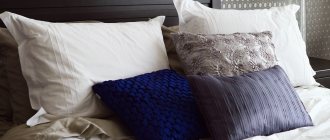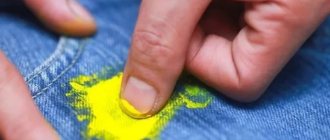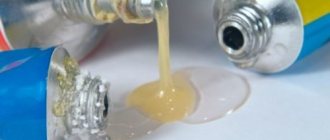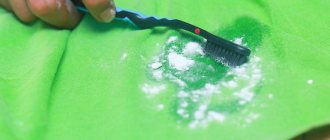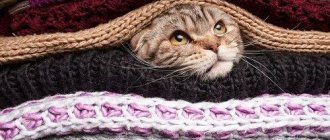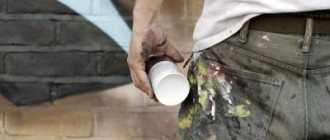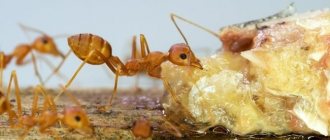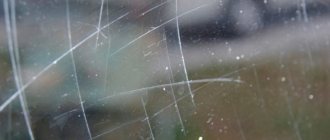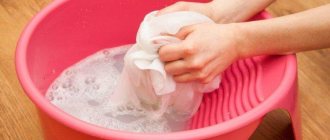How to remove pills from socks?
The pellets can be carefully cut off with a razor or a machine with a small grid diameter. If the socks are made of thick yarn, they must be combed out with a comb or removed with nail scissors.
Interesting materials:
Who plays Dota? Who plays lol? Which animal searches for truffles? Who studied the territory of Central Asia? Who has studied Central Asia? Who controls the SBU? Who controls the labor inspectorate? Who is the Queen of New Zealand? Who dyes carrots underground answer? Who loves black?
How to care for clothes to prevent pilling from appearing longer
Since friction is to blame for the appearance of pellets, it should be avoided if possible. Here's what to do.
- Follow the washing cycle indicated on the clothing. Before throwing things into the machine, turn them inside out so that their front sides rub less against each other and against the drum.
- Wash woolen items in a special mesh.
- Use laundry conditioner. It softens the fibers and they straighten out.
- Don’t get carried away with machine drying: it also creates excess friction.
- Be careful with bags. Any straps and backpacks damage clothing in the shoulder area. If you don’t like to carry your bag in your hand, choose wide soft straps.
- Keep your hands in the pockets of your woolen coat as little as possible, otherwise the surface around the pockets and around the cuffs will become matted.
- Do not rub the item unnecessarily. Do not wash out stains - it is better to use a stain remover.
- Pay attention to your choice of clothing. High-quality fabrics are less prone to pilling.
- Be careful with Velcro fasteners: they leave snags on knitted clothing and damage the fibers, which can later become matted.
Our tasks
The network of dry cleaners in Moscow “Clean Land” is designed to provide individuals and legal entities with the highest quality and modern services in the shortest possible time and little money. For the largest metropolis, this is extremely important, and our company provides not only impeccable service, but also high quality cleaning. The work uses the latest generation equipment and uses the safest drugs possible.
Management pays special attention to personnel training. The tasks of the employees include not only polite and competent service to visitors, as well as high-quality work and compliance with their positions, but also constant professional self-improvement. Thanks to this approach, we provide high-quality express dry cleaning of clothes in Moscow, and our company’s clients wear clean, fresh clothes.
How to choose clothes
As we have already said, it is impossible to predict whether pilling will appear on a particular garment. Although there are a few tricks to keep your items looking their best for longer.
- First, try not to buy clothes made from mixed fabrics. Knitted or woven fabrics that combine different types of yarns, especially natural and synthetic fibers, are more prone to pilling. Just check the labels before you take the item to the checkout.
- Secondly, choose woven rather than knitted items. But if it comes to knitwear, then give preference to a denser knit.
Life hack 7 - use a new sponge to wash dishes
A very interesting and effective way to remove pellets. Take a new dish sponge and scrub the jersey with the rough side. This will help you remove any new pills from your clothes.
Important! This method of removing pellets is suitable for the most delicate fabrics. Therefore, if you are afraid of ruining the fabric, use it.
Lifehack 6 - haircut
If large pills form on clothing, you can simply cut them off with sharp scissors. This is a rather long and labor-intensive process, how to remove pills from a sweater? since you will need to cut off the lumps one by one, one by one. There is also a possibility of damaging wool trousers, a dress or a jacket.
Advice! To make it easier for you to remove pellets, first comb your sweater with a fine-tooth comb. The comb will remove the smallest lumps and it will be easier for you to remove all the remaining pellets.
We remove pellets using traditional methods
Next - only the simplest and most harmless methods that do not require any money. By testing you can choose the most suitable one
The key is to approach things with caution.
Razor
The razor method comes in handy most of all when you need to remove uneven surfaces from bed linen and other similar types of fabrics with a smooth surface. Some smooth types of knitwear are also convenient to process using the machine (hats, gloves, mittens, tights, socks). Using a razor to remove pellets from pants or coats is also quite easy. The main thing is not to overdo it with pressure, so as not to permanently ruin the thing.
To remove pellets, you just need to move the shaving machine over the fabric, removing small lumps. The razor should be guided in the direction of the grain to reduce the risk of damage to the threads. After the procedure, simply shake off the item. It is more convenient to remove pills on tights, socks or gloves by putting the item on yourself.
Scissors
Before picking up the scissors, lightly go over the fabric with a massage comb - then it will be easier to remove excess elements. The spools need to be cut off one at a time. You need to hold the scissors in such a way as to remove matted fibers only with the tips. The remaining small fibers can be removed with a razor.
It is tape that is best used when you need to remove defects from a sweater. It will remove lumps that easily come off the surface, without damaging the main fabric. The main condition is that the tape must be wide and highly adhesive, and the pellets must be fresh.
Cut a piece of tape approximately 20 cm long. Glue it to the fabric, smooth it with your hands and wait about 10 seconds. With a quick and sharp movement, tear off the tape, holding the fabric close to the tearing point. So gradually it is necessary to process the whole thing. A new piece of adhesive tape is required each time.
Toothbrush
It is very important when using a toothbrush: to find a balance between strong pressure and light gliding. Although this method is the safest
Pills on thin and delicate, even fluffy things can be removed without fear with this hygienic device
Although this method is the safest. Rolls on thin and delicate, even fluffy items can be removed without fear with this hygienic device.
So, to remove pellets from a sweater, take a medium-hard brush. Even an old one will do. Make a vinegar solution by combining equal amounts of acid and water. Dip a brush in it. Gradually, section by section, treat the problem area with short movements along the grain. Be patient - the process will take you a lot of time. Afterwards, rinse the item in this solution. This will bring back her fluffiness.
A sponge with a hard abrasive part is suitable for processing. There is no need to get it wet, just rub it on the desired area using upward movements along the fibers. Gradually the balls will detach.
Comb
A comb can also combat pellets on things. You need to find one in which the distance between the teeth is minimal. You can simply run along the fibers (in both directions). Most often, most of the lumps remain on the comb. Or you can use it as an auxiliary tool to make it more convenient to remove lumps with nail scissors.
The method can be tried on any type of fabric. You only need to be careful with large knitting. There is a risk of accidentally catching the threads with the teeth.
Roller for clothes
The clothes cleaning roller removes not only excess lint, wool and dust. This handy tool can also remove pellets. The only downside is that the tape, as a rule, is not designed for large and old lumps. But fresh, leaky ones can easily be removed.
In this case, it is more convenient to put the clothes on someone - this will make it easier to treat the surface. As soon as the roller has collected so much lint and pellets that it stops sticking, change the tape.
Sandpaper
Sandpaper is good at removing lumps from clothes made of wool, linen and cotton. It is better not to experiment with it on delicate fabrics.
Crackers
Cleaning clothes from pills with breadcrumbs is an old, rarely used method. However, it is effective. It is also suitable for delicate textiles. Try it yourself!
To be absolutely sure of the result, it is better to make the crackers yourself. Take bread (preferably loose). Cut it into pieces so that it is convenient to hold in your hand when processing. Place them on a baking sheet and place them in the oven over low heat to dry. At each stage of preparation, ensure that the bread is kept away from oil and other fat.
Features of removing pellets from different materials
When choosing a method for removing pellets, it is worth considering the type of material. Then the cleaning will be most effective.
Woolen
Wool is a fleecy fabric whose fibers mat even with proper care. To put the material in order without spoiling it, use the following means:
- Combination of comb and scissors. Small pellets are combed out with a comb, and the remains are cut off with scissors.
- Hair products. The rolled material is first washed in hair shampoo. Then the fabric is soaked in balm or conditioner and left for an hour. Clothes are rinsed thoroughly.
- Toothbrush. It is used like a comb.
Complement the topic of the video:
Cashmere
Cashmere is another type of fleecy fabric. To clean it, the same methods are used as for wool. When using an electric trimmer, use the attachment for delicate fabrics.
Knitwear
Knitwear is not a fleecy material. To clean it, it is recommended to use:
- tape and sticky roller;
- sponge;
- razor;
- standard electric trimmer attachment.
Drape
Drape is a rough coat fabric. To remove pellets from such textiles use:
- razor;
- standard trimmer attachment;
- tape and adhesive tape;
- scissors (without comb);
- sandpaper;
- sponge;
- crackers.
Lifehack 9 - bread crumbs
A very unusual thing can help you in removing pellets from woolen items - bread crumbs. You can use this method to remove pills from clothes if you have nothing else at hand. You will need a thick piece of cracker; thin pieces will crumble quickly. The easiest way is to dry it yourself in the oven or naturally. Moreover, you need to dry the cleaning rusk on a non-greasy surface, otherwise your clothes will acquire a greasy sheen. And choose loose bread for drying so that it removes unnecessary lint from the fabric.
After drying the bread, simply use it to clean the pellets from your clothes. They will cling to it and be removed from the clothes.
Prevention measures
What to do to prevent the problem from occurring:
- You need to wash your favorite items according to the label that is attached to the clothes. Do not exceed the temperature range or use automatic spinning if this is contraindicated.
- Fabrics that require careful handling should only be washed by hand using special products for this type of material.
- Use conditioner designed for rinsing.
- Do not use bleaches on synthetic fabrics.
To prevent pilling, it is recommended to avoid excessive rubbing of clothing against the bag.
Carrying a bag always on one shoulder can cause pilling
Lifehack 10 - dry cleaning
Pills on clothes on expensive delicate fabrics are best removed by dry cleaning. This method is quite expensive, but it will allow you to save your favorite thing and not spoil it. In addition, you will have a guarantee that you will receive it back in perfect condition and without stains.
This method of removing pills from clothes is suitable when you have already tried all the home methods and nothing has worked for you. The dry cleaner will clean your favorite wool pants quickly and easily.
Machine for removing pellets
The use of a special mechanism will help remove pills from clothes and give them a presentable look. The option is not cheap, but reliable, allowing you to get rid of matted lumps. A similar device is suitable for wool (for example, angora, mohair) and knitted fabrics.
The device cuts the balls very carefully and does not damage the fabric. When choosing a shaver at a budget price, you should make sure that the height of the knife is adjustable. This is necessary so that soft balls can be cleaned from decorated fabrics without damaging rhinestones, embroidery, other decorations and the material itself.
Such a device is equipped with a container into which the pellets are collected. It runs on both batteries and mains power. The dimensions of the device are small; it fits easily in a purse. Therefore, you can take it when leaving, for example, on vacation or on a business trip. In addition, the mini machine is safe to use.
Disadvantages include fragility and rapid dulling of the blades, which leads to a decrease in the result obtained. Also, cleaning one item with an inexpensive model will take longer than using a more expensive option. Cheap shaver batteries run out faster and containers fill up with pellets. This extends the process of cleaning things over time, since it is necessary to empty the containers of their contents.
Are all methods for removing lumps from clothes really effective?
There are a lot of tips on the Internet on how to get rid of pilling on a sweater, dress and trousers. Some methods are ineffective: the use of inappropriate products does not bring any benefit or leads to damage to the item, the appearance of small holes or stains.
Questionable methods for removing pellets:
- sandpaper, a dry piece of black bread, pumice, a coarse washcloth. If you rub the surface of the product with objects with a hard surface, it is easy to damage the material. Treatment with pumice and sandpaper can hopelessly ruin your favorite item;
- blade and scissors. Cutting the pellets is very difficult: filigree precision is required to remove the ball of hair without cutting a hole. Large spools on knitted items have a “leg” made of the main threads of the fabric. If scissors or a blade passes through this area, then the appearance of a hole is inevitable;
- scotch. The sticky surface collects only “fresh”, small pellets and only from dense, smooth surfaces;
- clothes or toothbrush. A well-advertised but ineffective method. It is very difficult to clean a jacket or sweater from hairballs; the pellets move left and right, some lag behind the surface, but most of the matted clumps remain in place. Active friction can lead to the appearance of new lumps on knitwear and woolen items.
Lifehack 4 - old men's razor
This method is ancient, almost everyone knows about it. Suitable for caring for smooth items, especially socks, knitted tights, hats. Where the knitted fabric is smooth, without patterns. In this case, it is best to use an old razor that is already slightly dull. A new one can easily cut the product.
How to remove pills from clothes at home using a razor:
- Stretch and secure the wool fabric so that you can handle it comfortably. Moreover, you should not stretch it too much - this can cause the clothes to stretch and lose their shape.
- Lean the razor against the surface of the fabric, without pressing it, but as if from above, cut off the pellets from the clothing. Run the razor from bottom to top across the clothing to catch as many pellets as possible.
- In this way, clean all the places on the sweater where pills have formed.
How to remove pills from clothes with a razor:
Important! This is a rather aggressive way to remove pellets from clothes; there is a high probability of cutting the fabric. Not suitable for caring for angora, cashmere, and mohair.
Where do the pellets come from?
thespruce.com
They appear on fabric when groups of short or damaged fibers intertwine into a tiny ball. This usually occurs as a result of friction or abrasion from the fabric during normal wear.
As a rule, the most pilling appears on those areas of clothing or bedding that are exposed to the greatest impact from everyday use. For example, in the center of the sheet, under the arms, around the collar and cuff of a shirt, and between the thighs and on the back of pants. But it also happens that pellets appear where you don’t expect them at all.
It is difficult to say whether pills form on a particular fabric. However, there are still some types of fabrics and fibers that are more susceptible to pilling. The most striking example is knitwear, because the threads of such fabric are looser. But fabrics made from long fibers - for example, silk and linen - pill less than wool, cotton, polyester and other synthetics. When a fabric is made from different fibers, such as a cotton/polyester blend, one fiber is usually stronger than the other. As a result, the weaker one will tear, tie itself around the stronger one and form a hated tangle.
During washing, such a ball will become a kind of magnet for other loose threads, which will eventually get tangled. This is why white pellets appear on black fabric: they simply consist of other, weaker fibers.

